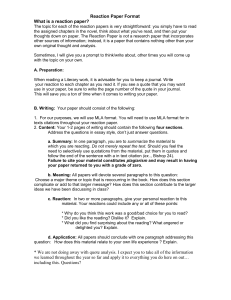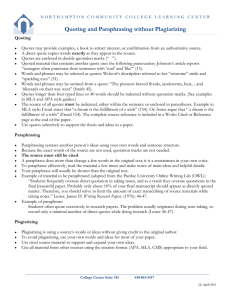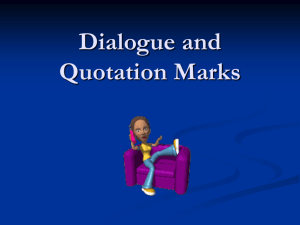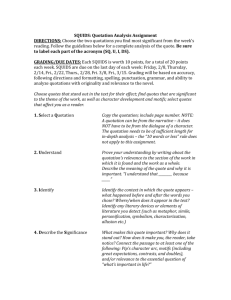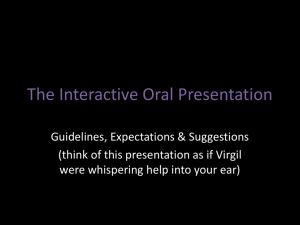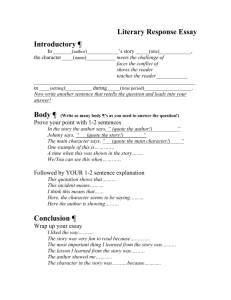MLA for ENG 102
advertisement
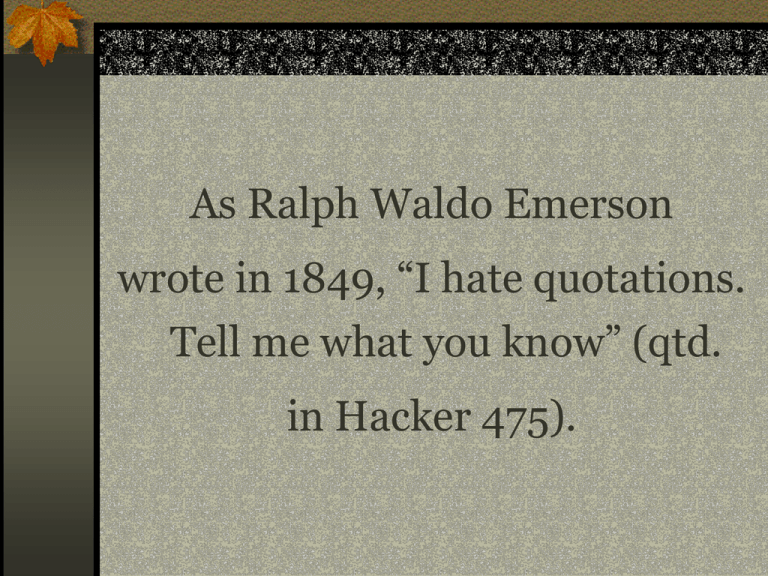
As Ralph Waldo Emerson wrote in 1849, “I hate quotations. Tell me what you know” (qtd. in Hacker 475). Quotes MLA Style Quotes are used to support and enhance your own writing; don’t let the quoted material write your essay for you. When you do use material from another source, you must document that source. Integrating quotes Use sparingly Place generally in the body of the paragraph Use as supporting evidence to develop your paragraph Explain its relevance or interpret its meaning--always set up and follow up the quotation Reasons to Use Quotations I. For support II. To preserve vivid or technical language III. To comment on the quotation IV. To gain distance through quotation I. For support A. From an authority: Sara Mosle, a sixth-grade teacher and education author, explains that electronic communication between parent and teacher is popular: “The appeal is obvious: communication can be asynchronous and delivered with the tap of thumb” (SR7). B.To reinforce or expand on your point: The English settlers showed no remorse for spreading new diseases that devastated the populations of the indigenous people of the northeast. Historians Amy Segal and Frank Stinebeck note that the settlers considered these epidemics “the hand of God making room for His followers in the New World” (32). Or… The English settlers showed no remorse for spreading new diseases that devastated the populations of the indigenous people of the northeast. Historians note that the settlers considered these epidemics “the hand of God making room for His followers in the New World” (Segal and Stinebeck 32). * if three or more authors, cite first author and add “et al.” (Segal et al. 32). II. Vivid or Technical Language Quote a sentence that is compact or relies on a striking image to make its point: In commenting on trying to understand the Holocaust, Woody Allen said it “was not such a puzzle if I understood that inside every heart live the worm of self-preservation, of fear, greed, and an animal will to power” (qtd in Strang 468). B. To retain the precise terminology in technical or legal material: Chief Justice Warren wrote, “Segregation of children in public schools solely on the basis of race, even though the physical facilities and other "tangible" factors may be equal, deprive the children of the minority group of equal educational opportunities” (Brown vs. Board). III. To Comment on the Quotation To analyze or comment on a statement made by another writer, readers should have that writer’s exact words in front of them…you have to quote in order to talk about it. For example: Worst of all is the overwritten prologue about John Lennon’s death and its impact on Liverpool. Author John Norman states, “The ruined imperial city, its abandoned river, its tormented suburban plain, knew an anguish greater than recession and unemployment, more deadly than Hitler’s blitz” (2). Norman and his publishers should have realized that this statement was out of proportion to the devastation of World War II. IV. Gaining Distance From an obsolete phrase: Many “flower children” gathered at rock festivals in the 1960s. From slang: The actor was thought of as handsome “back in the day.” Or to achieve irony: His “constant companion,” a Chihuahua, traveled with him everywhere. MLA Parenthetical Documentation Requires that you provide full documentation only once for each source Places that citation in Works Cited at end of paper Within paper, gives brief references, in parentheses, to sources cited Parenthetical Reference Format Begin parens one space after material cited Place quotation marks before parens Place periods, commas and semicolons after parens Ex: …last word” ( ). Parenthetical Referencing Follow the quote with a parenthesis that includes all information necessary for the reader to find it in your Works Cited page: “There was nothing so humiliating as being unable to express myself” (???). You only need to supply in parentheses the information not included in the essay’s text. Therefore: If you introduce the quote with the author’s name, then only include the page number: According to author Jimmy Santiago Baca when asked to read, “I felt the hang-rope tighten around my neck and the trapdoor creak beneath my feet” (352). He felt “vulnerable, ridiculed and scorned” when his inability to make sense of printed words showed (353). Note both the signal phrase and paraphrasing If you don’t include the author’s name, supply it in the parenthesis: One author describes his first journal: “One day I tore two flaps from the cardboard box that held all my belongings [and] … threaded the holes with a shoestring” (Baca 355). Two works, same author? If you quote more than one work by the same author, supply the name of the work in the parenthesis: Baca describes his first journal as “two flaps from the cardboard box that held all my belongings. … sketched on the cover [was] a hummingbird” (“Coming Into Language” 355). Quoting someone quoting someone… If you use a source in which the author is quoting another person, be sure to include this information parentheses: Critics of Legos argue the company has sold out on fostering creativity in children. One parent complains, “What stinks about Lego sets now is that they’re not imaginative at all” (BagatelleBlack qtd in Richtel SR4). The sets are tied to “billion dollar franchises like Lord of the Rings” with detailed directions, not a child’s imagination (Richtel SR4). Don’t know the author? Use the title of the article, only as much as is necessary for identification on Works Cited page. The Associated Press reports that “Arizona’s record for teaching children to read is dismal” (“Creighton’s…” A24). Full title of news article is “Creighton’s 3year effort represents partnership” The Botos MLA rule Even though MLA states no page number is necessary if one doesn’t appear on the original, eg. articles from websites or html text printouts… Use the page number on your printout of the document. Exercises Put the following quotes in MLA as they would appear in your essay. The underlined text represents quotes. Remove the underline and place the quotation marks and other grammar in the correct MLA fashion. Don’t forget to place the appropriate information in the parentheses. From the book Know Your Brain by James Penfield Penfield was unable to use an electric probe on a volunteer’s brain to alter awareness. Despite trying to prove the reverse, Penfield showed that the brain’s activity always occurred within the dominating and enveloping radiance of an autonomous mind. (appears on page 58, only work by this author) Answer . The Nature Conservancy reports that as recently as 1976, Long Island’s bay men collected 700,000 bushels of clams. By 2003, those numbers were down 99 percent. (quote appears on website www.nature.org, printed out on p.4, article titled “Restoring Great South Bay.”) Answer Presenting information verses creating an argument: Your claim should be fresh and original All research should frame your issue and support your claim Sources should be credible, accurate, and as unbiased as possible No “data dumps”
